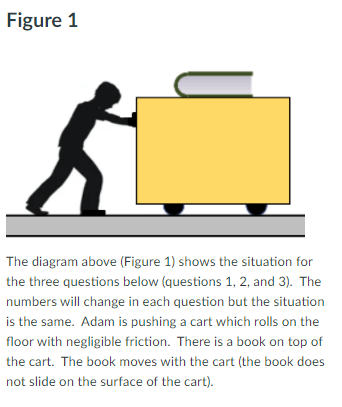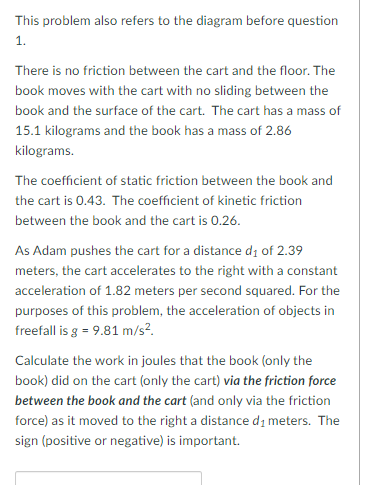Figure 1 The diagram above (Figure 1) shows the situation for the three questions below (questions 1, 2, and 3). The numbers will change in each question but the situation is the same. Adam is pushing a cart which rolls on the floor with negligible friction. There is a book on top of the cart. The book moves with the cart (the book does not slide on the surface of the cart).
Figure 1 The diagram above (Figure 1) shows the situation for the three questions below (questions 1, 2, and 3). The numbers will change in each question but the situation is the same. Adam is pushing a cart which rolls on the floor with negligible friction. There is a book on top of the cart. The book moves with the cart (the book does not slide on the surface of the cart).
Glencoe Physics: Principles and Problems, Student Edition
1st Edition
ISBN:9780078807213
Author:Paul W. Zitzewitz
Publisher:Paul W. Zitzewitz
Chapter5: Displacement And Force In Two Dimensions
Section: Chapter Questions
Problem 68A
Related questions
Question

Transcribed Image Text:Figure 1
The diagram above (Figure 1) shows the situation for
the three questions below (questions 1, 2, and 3). The
numbers will change in each question but the situation
is the same. Adam is pushing a cart which rolls on the
floor with negligible friction. There is a book on top of
the cart. The book moves with the cart (the book does
not slide on the surface of the cart).

Transcribed Image Text:This problem also refers to the diagram before question
1.
There is no friction between the cart and the floor. The
book moves with the cart with no sliding between the
book and the surface of the cart. The cart has a mass of
15.1 kilograms and the book has a mass of 2.86
kilograms.
The coefficient of static friction between the book and
the cart is 0.43. The coefficient of kinetic friction
between the book and the cart is 0.26.
As Adam pushes the cart for a distance d; of 2.39
meters, the cart accelerates to the right with a constant
acceleration of 1.82 meters per second squared. For the
purposes of this problem, the acceleration of objects in
freefall is g = 9.81 m/s?.
Calculate the work in joules that the book (only the
book) did on the cart (only the cart) via the friction force
between the book and the cart (and only via the friction
force) as it moved to the right a distance di meters. The
sign (positive or negative) is important.
Expert Solution
This question has been solved!
Explore an expertly crafted, step-by-step solution for a thorough understanding of key concepts.
This is a popular solution!
Trending now
This is a popular solution!
Step by step
Solved in 2 steps with 2 images

Knowledge Booster
Learn more about
Need a deep-dive on the concept behind this application? Look no further. Learn more about this topic, physics and related others by exploring similar questions and additional content below.Recommended textbooks for you

Glencoe Physics: Principles and Problems, Student…
Physics
ISBN:
9780078807213
Author:
Paul W. Zitzewitz
Publisher:
Glencoe/McGraw-Hill

Glencoe Physics: Principles and Problems, Student…
Physics
ISBN:
9780078807213
Author:
Paul W. Zitzewitz
Publisher:
Glencoe/McGraw-Hill